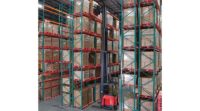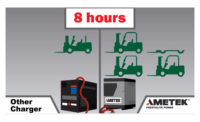Lift Truck Safety Concerns for Cold Storage
Refrigerated and frozen food operations introduce additional layers of complexity demanding specialization.

Forklift safety is a critical consideration across industries, with OSHA estimating approximately 35,000 serious injuries involving forklifts annually in warehouses and distribution centers. Although many incidents, like tip-overs, pedestrian collisions, falling loads and impacts with other equipment or objects, are common across all warehouse environments, cold and frozen food operations introduce additional layers of complexity demanding specialization.
Forklifts and freezers bring additional safety concerns. Freezers come in all shapes, sizes and operating temperatures – from grocery freezers maintaining 10 degrees Fahrenheit, to blast freezers that maintain temperatures as low as -40 degrees Fahrenheit. Most lift truck manufacturers can put together a package specifically designed for operating at low temperatures. But, regardless of the type of freezer in which they’re operating, forklifts – even when specially equipped for the cold – are not meant to live in a freezer full time.
Safety concerns specific to freezer environments include:
- Duration of operation: The amount of time spent in low temperatures is a primary concern for both equipment and operators.
- Temperature transition: Condensation on the floor of the cab creates a potential slipping hazard for the operator and condensation on the truck can drip onto the warehouse floor and freeze, turning it into a skating rink. This is especially true in transition areas where the trucks are moving between freezing and ambient temperatures. Good housekeeping practices to monitor and remove ice buildup, whether manually or with food-friendly salts, goes hand-in-hand with lift truck best practices in keeping these areas safe.

Forklift Maintenance for Cold Storage Environments
Due to the effects of cold on hydraulics, electrical and other systems, lift truck maintenance checklists are more extensive for refrigerated and frozen food operations. A consistent inspection schedule and periodic preventative maintenance are critical. Some areas of concern include:
- Condensation: Because the lift trucks used in cold storage environments are electric trucks, care must be taken to prevent moisture from compromising its electrical system. Water can also permeate bushings and bearings, deteriorating the grease. Condensation can result in damage to bearings and load wheels occurring more frequently if not properly maintained.
- Food safety: Even operations that only handle finished food products are wary of any potential for contamination. Make it a standard practice to check forklifts for rust and fluid leaks that could risk compromising food products and packaging.
- Damage and poor operating practices: Lift trucks that work extensively in freezers are often prone to more abuse than those used in ambient environments. Operators don’t want to remain in the cold any longer than they must, and in their haste to get in and out as quickly as possible, trucks and racking can be subject to additional wear and damage.
Full-scale periodic maintenance with a good service partner that can monitor operational hours and mechanical condition is crucial to keeping lift truck fleets operational and safe.
Outfitting Lift Trucks for Cold Storage Operations
Outfitting a lift truck for operation in cold storage environments means little, if any changes to the chassis or general makeup of the truck. While most updates are subtle and out of sight, they are critical to the longevity and performance of equipment, and safety and comfort of operators. Systems include:
- Electrical: The electronics are a focus, with connection points that are water sealed to protect electrical systems from damage due to condensation.
- Fluids: Hydraulic fluid and oils are swapped out for formulations with a lower operating temperature range. Typically, fluids for ambient temperature trucks have an operating range of 32 to 120 degrees Fahrenheit; freezer-rated fluids have a range of 0 to 120 degrees Fahrenheit; and sub-zero rated fluids have a range of 40 to 80 degrees Fahrenheit below zero. However, advances in oils and hydraulic fluids have enabled a much broader operating range. This is important because many operations don’t have a dedicated freezer fleet, meaning the trucks may be required to operate in both ambient and sub-zero environments.
- Specially designed cabs: Trucks used in freezers are typically designed with cabs that are expanded with larger operating platforms or seats to accommodate the extra bulk of the operator’s protective clothing. Additionally, floors can be covered with porous material or equipped with drain holes to help prevent water buildup that could become a slipping hazard.
- Controls: Heated cabs and controls can allow operators to wear less bulky protective gear and gloves. This is particularly important for operations in warmer climates, where the temperature transition from freezer to ambient temperatures can be particularly extreme.
- Battery technology: Both lithium-ion and lead-acid batteries must be equipped to avoid damage from condensation and perform in low temperatures. Sealed battery compartments, sealed connections, battery management software and built-in heaters are all available to make batteries viable solutions for cold environments.
- Tires: Just as cars in northern climates need snow tires, lift trucks need proper tires to operate safely and effectively in cold storage environments. From standard drive tires with diagonal treads to push water away in areas with standing water, to tires with rough surfaces that can grip on icy surfaces, there are a wide variety of tire options available to suit most conditions.
Although there are many factors for cold storage warehouse operations to consider when it comes to lift truck safety and related issues, a foundational key to success is establishing a culture of safety. A major issue facing warehouses today – especially in the refrigerated and frozen space – is retention of talent. With new operators joining on a regular basis, it is essential to have well-established safety practices.
New technologies are becoming available to support lift truck safety and make them operate more effectively in refrigerated and frozen environments. Navigating the complexities of cold storage operations demands a strategic approach to forklift safety. By combining tailored equipment solutions, rigorous maintenance practices and a robust safety culture, warehouses can mitigate risks and sustain efficiency, even in the most challenging environments.
Looking for a reprint of this article?
From high-res PDFs to custom plaques, order your copy today!






